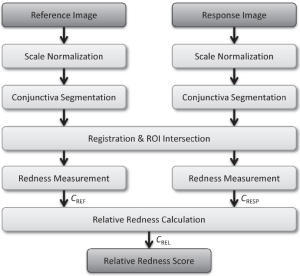Quantitative Conjunctival Provocation Test for Controlled Clinical Trials

The conjunctival provocation test (CPT) is a diagnostic procedure for the assessment of allergic diseases. Photographs are taken before and after provocation increasing the redness of the conjunctiva due to hyperemia. We propose and evaluate an automatic image processing pipeline for objective and quantitative CPT. After scale normalization based on intrinsic image features, the conjunctiva region of interest (ROI) is segmented combining thresholding, edge detection and Hough transform. Redness of the ROI is measured from 0 to 1 by the average pixel redness, which is defined by truncated projection in HSV space. In total, 92 images from an observational diagnostic study are processed for evaluation. The database contains images from two visits for assessment of the test-retest reliability (46 images per visit). All images were successfully processed by the algorithm. The relative redness increment correlates between the two visits with Pearson's r=0.672 (p<.001). Linear correlation of the automatic measure is larger than the manual measure (r=0.59). This indicates a higher reproducibility and stability of the automatic method. We presented a robust and effective way to objectify CPT. The algorithm operates on low resolution, is fast and requires no manual input. Quantitative CPT measures can now be established as surrogate endpoint in controlled clinical trials.
@article{Sarandi14MIM,
title={Quantitative conjunctival provocation test for controlled clinical trials},
author={S\'ar\'andi, I and Cla{\ss}en, DP and Astvatsatourov, A and Pfaar, O and Klimek, L and M{\"o}sges, R and Deserno, TM},
journal={Methods of information in medicine},
volume={53},
number={04},
pages={238--244},
year={2014},
publisher={Schattauer GmbH}
}

